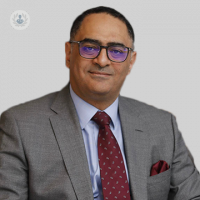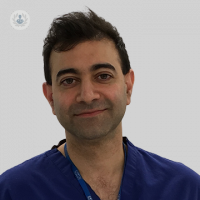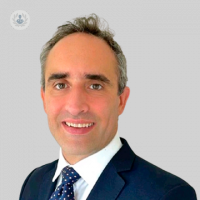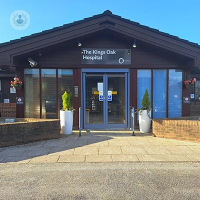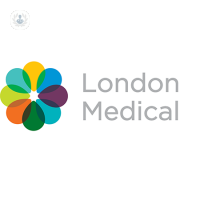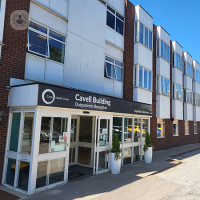What is adenomyosis?
Adenomyosis is condition in which the uterine lining (the endometrium) protrudes through the muscle wall of the uterus (the myometrium). As a result, the person suffering from adenomyosis can experience discomfort and have problems with menstruation. This is not a life-threatening condition and it is considered benign. However, the symptoms can have a significantly negative effect on the quality of life of those with it.

What are the symptoms of adenomyosis?
Although sometimes there are no symptoms experienced with adenomyosis, common adenomyosis symptoms include:
- Painful menstrual cramps
- Abdominal bloating
- Heavy, prolonged menstrual bleeding
- Pain during intercourse
- Blood clots which pass during menstruation
- Enlarged uterus
Normally, symptoms are first noticed after having children, or if not, in the later childbearing years.
What causes adenomyosis?
The cause of adenomyosis is unknown, however, it typically goes away after menopause, which suggests that the cause is hormone related.
Does adenomyosis cause a big belly?
One of the symptoms of adenomyosis is that the uterus can become enlarged. You may feel tender in your lower abdomen, or pressure in the area.
What are the chances of getting pregnant if I have adenomyosis?
Generally, adenomyosis doesn't result in infertility but in painful periods, heavy menstrual bleeding and the symptoms mentioned above. There's no definite evidence that this condition affects the ability to get pregnant or carry a pregnancy to term.

What's the difference between adenomyosis and endometriosis?
Adenomyosis and endometriosis share similarities and have various differences. They are both disorders of the uterine lining, but they develop differently and have symptoms that are different to one another.
In endometriosis: The endometrial-like tissue that grows outside of the uterus is commonly found on the ovaries. It then becomes part of the menstrual cycle and may cause pain and affect fertility.
In adenomyosis: Endometrial-like cells grow within the uterus' muscles. These cells also follow the menstrual cycle and may cause pain and heavy bleeding due to the uterus wall thickening. You can have both disorders at the same time.
How is adenomyosis treated?
As adenomyosis usually goes away after menopause, treatment options depend on how old you are or if you have finished having children. For women nearing menopause, anti-inflammatory medications such as ibuprofen can be given to help manage pain. If these are taken in the days leading up to menstruation, bleeding should be lighter. Milder symptoms can be dealt with using over-the-counter pain relief and heat packs to help with cramps. Certain hormone contraceptives can also sometimes help with symptoms of heavy bleeding and cramps.

Endometrial ablation, which destroys uterine lining can help manage symptoms as well. Uterine artery embolisation, which blocks certain blood vessels leading to the uterine lining can help relieve pain, too. This is because the blood supply gets cut off from the affected area, which shrinks the uterine lining as a result.
Finally, if the pain experienced is severe, and menopause is a long way off, sometimes a hysterectomy will be recommended. However, this is a serious decision that only an expert would recommend on careful consideration.
Which specialist treats adenomyosis?
Gynaecologists treat adenomyosis. It's very important to receive expert attention, so the difference between endometriosis and adenomyosis is established.
04-17-2018 04-26-2023Adenomyosis
Mr Mahantesh Karoshi - Obstetrics & gynaecology
Created on: 04-17-2018
Updated on: 04-26-2023
Edited by: Karolyn Judge
What is adenomyosis?
Adenomyosis is condition in which the uterine lining (the endometrium) protrudes through the muscle wall of the uterus (the myometrium). As a result, the person suffering from adenomyosis can experience discomfort and have problems with menstruation. This is not a life-threatening condition and it is considered benign. However, the symptoms can have a significantly negative effect on the quality of life of those with it.

What are the symptoms of adenomyosis?
Although sometimes there are no symptoms experienced with adenomyosis, common adenomyosis symptoms include:
- Painful menstrual cramps
- Abdominal bloating
- Heavy, prolonged menstrual bleeding
- Pain during intercourse
- Blood clots which pass during menstruation
- Enlarged uterus
Normally, symptoms are first noticed after having children, or if not, in the later childbearing years.
What causes adenomyosis?
The cause of adenomyosis is unknown, however, it typically goes away after menopause, which suggests that the cause is hormone related.
Does adenomyosis cause a big belly?
One of the symptoms of adenomyosis is that the uterus can become enlarged. You may feel tender in your lower abdomen, or pressure in the area.
What are the chances of getting pregnant if I have adenomyosis?
Generally, adenomyosis doesn't result in infertility but in painful periods, heavy menstrual bleeding and the symptoms mentioned above. There's no definite evidence that this condition affects the ability to get pregnant or carry a pregnancy to term.

What's the difference between adenomyosis and endometriosis?
Adenomyosis and endometriosis share similarities and have various differences. They are both disorders of the uterine lining, but they develop differently and have symptoms that are different to one another.
In endometriosis: The endometrial-like tissue that grows outside of the uterus is commonly found on the ovaries. It then becomes part of the menstrual cycle and may cause pain and affect fertility.
In adenomyosis: Endometrial-like cells grow within the uterus' muscles. These cells also follow the menstrual cycle and may cause pain and heavy bleeding due to the uterus wall thickening. You can have both disorders at the same time.
How is adenomyosis treated?
As adenomyosis usually goes away after menopause, treatment options depend on how old you are or if you have finished having children. For women nearing menopause, anti-inflammatory medications such as ibuprofen can be given to help manage pain. If these are taken in the days leading up to menstruation, bleeding should be lighter. Milder symptoms can be dealt with using over-the-counter pain relief and heat packs to help with cramps. Certain hormone contraceptives can also sometimes help with symptoms of heavy bleeding and cramps.

Endometrial ablation, which destroys uterine lining can help manage symptoms as well. Uterine artery embolisation, which blocks certain blood vessels leading to the uterine lining can help relieve pain, too. This is because the blood supply gets cut off from the affected area, which shrinks the uterine lining as a result.
Finally, if the pain experienced is severe, and menopause is a long way off, sometimes a hysterectomy will be recommended. However, this is a serious decision that only an expert would recommend on careful consideration.
Which specialist treats adenomyosis?
Gynaecologists treat adenomyosis. It's very important to receive expert attention, so the difference between endometriosis and adenomyosis is established.


All you need to know about adenomyosis
By Mr Mahantesh Karoshi
2024-11-08
In our latest article, we find out what exactly adenomyosis is, what the main symptoms and causes are, and how this female-affecting condition can be most effectively treated. See more


Health issues in modern women vs women in the past: a comparative analysis
By Mr Mahantesh Karoshi
2024-11-08
The transition from traditional to modern lifestyles has brought about significant changes in various aspects of our lives. In the context of women's health, there is a growing concern that modern women are more prone to conditions such as premenstrual syndrome (PMS), endometriosis, adenomyosis, and fibroids. Mr Mahantesh Karoshi, leading women’s health expert and consultant gynaecologist aims explores the potential reasons behind this increased vulnerability, attributing it to the shift in lifestyle factors such as dietary choices and sedentary habits. See more
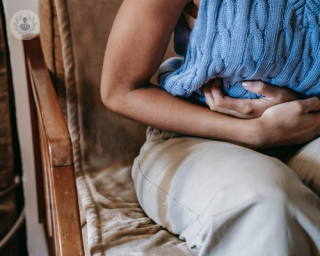

The connection between adenomyosis and lower back pain
By Mr Mahantesh Karoshi
2024-11-08
Adenomyosis is a common gynaecological condition characterised by the presence of endometrial tissue within the uterine wall. In this article, leading consultant gynaecologist Mr Mahantesh Karoshi explores potential mechanisms underlying this connection and discusses managing lower back pain in patients with adenomyosis. See more


Adenomyosis: what is it and how does it differ from endometriosis?
By Dr Shazia Malik
2024-11-07
Statistics show that as many as 1 in 10 women in the UK suffer from adenomyosis, a painful condition of the uterus which can often be confused with endometriosis. Revered consultant obstetrician and gynaecologist Dr Shazia Malik explains the condition, including symptoms, treatment options and how it can be diagnosed. See more
Experts in Adenomyosis
-
Mr Mahantesh Karoshi
Obstetrics & gynaecologyExpert in:
- Heavy periods
- Polycystic ovary syndrome (PCOS)
- Infertility
- Ovarian cyst
- Adenomyosis
- Miscarriage
-
Mr Mohamed Mabrouk
Obstetrics & gynaecologyExpert in:
- Endometriosis
- Myomectomy
- Fibroids
- Hysterectomy
- Menstrual disorders
- Adenomyosis
-
Mr Ilyas Arshad
Obstetrics & gynaecologyExpert in:
- Minimal access surgery (keyhole surgery)
- Endometriosis
- Adenomyosis
- Pelvic pain
- Fibroids
- Menstrual disorders
-
Mr Shaheen Khazali
Obstetrics & gynaecologyExpert in:
- Endometriosis
- Adenomyosis
- Hysterectomy
- Robotic surgery
- Fibroids
- Heavy periods
-
Dr Aidan Shaw
Interventional radiologyExpert in:
- Venous access
- Pelvic congestion syndrome
- Fibroids
- Adenomyosis
- Varicocele
- Prostate artery embolisation
- See all

Kings Oak Hospital - part of Circle Health Group
Kings Oak Hospital - part of Circle Health Group
127 The Ridgeway, Enfield EN2 8JL
No existe teléfono en el centro.
By using the telephone number provided by TOP DOCTORS, you automatically agree to let us use your phone number for statistical and commercial purposes. For further information, read our Privacy Policy
Top Doctors

London Medical
London Medical
49 Marylebone High Street, W1U 5HJ
No existe teléfono en el centro.
By using the telephone number provided by TOP DOCTORS, you automatically agree to let us use your phone number for statistical and commercial purposes. For further information, read our Privacy Policy
Top Doctors

The Cavell Hospital - part of Circle Health Group
The Cavell Hospital - part of Circle Health Group
Cavell Dr, Uplands Park Rd, Enfield EN2 7PR
No existe teléfono en el centro.
By using the telephone number provided by TOP DOCTORS, you automatically agree to let us use your phone number for statistical and commercial purposes. For further information, read our Privacy Policy
Top Doctors
-
Kings Oak Hospital - part of Circle Health Group
127 The Ridgeway, Enfield EN2 8JL, North LondonExpert in:
- Cancer
- Cardiology
- General Surgery
- Orthopaedic surgery
- Diagnostic Imaging
- Obstetrics and Gynaecology
-
London Medical
49 Marylebone High Street, W1U 5HJ, Central LondonExpert in:
- Cardiology
- Adult Diabetes
- Child Diabetes
- Endocrinology
- General practice
- Ophthalmology
-
The Cavell Hospital - part of Circle Health Group
Cavell Dr, Uplands Park Rd, Enfield EN2 7PR, North LondonExpert in:
- endoscopy
- Gastroenterology
- Shoulder and elbow
- Hand and wrist
- Otolaryngology
- Foot and ankle
- See all
- Most viewed diseases, medical tests, and treatments
- Weight loss injections
- Genetic testing
- Testicular ultrasound
- Nipple discharge
- Breast ultrasound
- Abdominal pain
- Endovenous laser treatment (EVLA)
- Minimal access surgery (keyhole surgery)
- Head and neck cancer
- Neck lump

